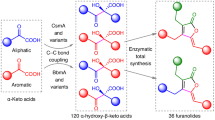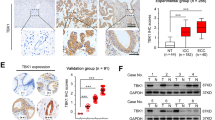Abstract
β-Carboline alkaloids and related compounds show a broad spectrum of biological activities. We previously identified new members of the β-carboline alkaloid family by using an engineered Kitasatospora setae strain and a heterologous Streptomyces host expressing the plausible biosynthetic genes, including the hypothetical gene kse_70640 (kslB). Here, we elucidated the chemical structure of a new tetrahydro-β-carboline compound (named kitasetalic acid) that appeared in a heterologous Streptomyces host expressing the kslB gene alone. Kitasetalic acid suppressed the expression of glucose-regulated protein 78 (GRP78) without inducing cell death. This is the first report to show that a tetrahydro-β-carboline compound regulates the expression of the GRP78 protein in cancer cell lines.
Similar content being viewed by others
Log in or create a free account to read this content
Gain free access to this article, as well as selected content from this journal and more on nature.com
or
References
Cao R, Peng W, Wang Z, Xu A. β-Carboline alkaloids: biochemical and pharmacological functions. Curr Med Chem. 2007;14:479–500.
Djamshidian A, Bernschneider-Reif S, Poewe W, Lees AJ. Banisteriopsis caapi, a forgotten potential therapy for Parkinson’s disease? Mov Disord Clin Pract. 2016;3:19–26.
Ngoc PB, et al. A new anti-inflammatory β-carboline alkaloid from the hairy-root cultures of Eurycoma longifolia. Nat Prod Res. 2016;30:1360–5.
Lee D-S, et al. Anti-methicillin-resistant Staphylococcus aureus (MRSA) substance from the marine bacterium Pseudomonas sp. UJ-6. Environ Toxicol Pharmacol. 2013;35:171–7.
Li Y, et al. DH334, a β-carboline anti-cancer drug, inhibits the CDK activity of budding yeast. Cancer Biol Ther. 2007;6:1193–9.
Shankaraiah, N et al. Synthesis of novel C3-linked β-carboline-pyridine derivatives employing khronke reaction: DNA-binding ability and molecular modeling studies. Lett Drug Des Discov. 2016;13:335–42.
Song Y, et al. Specific inhibition of cyclin-dependent kinases and cell proliferation by harmine. Biochem Biophys Res Commun. 2004;317:128–32.
Kamal A, et al. Design and synthesis of dithiocarbamate linked β-carboline derivatives: DNA topoisomerase II inhibition with DNA binding and apoptosis inducing ability. Bioorg Med Chem. 2015;23:5511–26.
Herraiz T, Chaparro C. Human monoamine oxidase enzyme inhibition by coffee and β-carbolines norharman and harman isolated from coffee. Life Sci. 2006;78:795–802.
Glennon RA, et al. Binding of β-carbolines and related agents at serotonin (5-HT2 and 5- HT1A), dopamine (D2) and benzodiazepine receptors. Drug Alcohol Depend. 2000;60:121–32.
Herraiz T, González D, Ancín-Azpilicueta C, Arán VJ, Guillén H. β-Carboline alkaloids in Peganum harmala and inhibition of human monoamine oxidase (MAO). Food Chem Toxicol. 2010;48:839–45.
Kim CK, et al. Manzamine Alkaloids from an Acanthostrongylophora sp. Sponge. J Nat Prod. 2017;80:1575–83.
Stanković D, Mehmeti E, Svorc L, Kalcher K. New electrochemical method for the determination of β-carboline alkaloids, harmalol and harmine, in human urine samples and in Banisteriopsis caapi. Microchem J. 2015;118:95–100.
Fotso S, et al. Furan oligomers and β-carbolines from terrestrial streptomycetes. J Nat Prod. 2008;71:1630–3.
Yang ML, Kuo PC, Hwang TL, Wu TS. Anti-inflammatory principles from Cordyceps sinensis. J Nat Prod. 2011;74:1996–2000.
Aroonsri A, Kitani S, Ikeda H, Nihira T. Kitasetaline, a novel β-carboline alkaloid from Kitasatospora setae NBRC 14216T. J Biosci Bioeng. 2012;114:56–58.
Aroonsri A, et al. Pleiotropic control of secondary metabolism and morphological development by KsbC, a butyrolactone autoregulator receptor homologue in Kitasatospora setae. Appl Environ Microbiol. 2012;78:8015–24.
Komatsu M, Uchiyama T, Omura S, Cane DE, Ikeda H. Genome-minimized Streptomyces host for the heterologous expression of secondary metabolism. Proc Natl Acad Sci. 2010;107:2646–51.
Pulsawat N, Kitani S, Fukushima E, Nihira T. Hierarchical control of virginiamycin production in Streptomyces virginiae by three pathway-specific regulators: VmsS, VmsT and VmsR. Microbiology. 2009;155:1250–9.
Mukaihara T, Tamura N, Murata Y, Iwabuchi M. Genetic screening of Hrp type III-related pathogenicity genes controlled by the HrpB transcriptional activator in Ralstonia solanacearum. Mol Microbiol. 2004;54:863–75.
Berridge MV, Tan AS. Characterization of the cellular reduction of 3-(4,5-dimethylthiazol-2-yl)-2,5-diphenyltetrazolium bromide (MTT): subcellular localization, substrate dependence, and involvement of mitochondrial electron transport in MTT reduction. Arch Biochem Biophys. 1993;303:474–82.
Namba T, et al. CDIP1-BAP31 complex transduces apoptotic signals from endoplasmic reticulum to mitochondria under endoplasmic reticulum stress. Cell Rep. 2013;5:331–9.
Suzuki K, Tanaka N, Kamada H, Yamashita I. Mikimopine synthase (mis) gene on pRi1724. Gene. 2001;263:49–58.
Saify ZS, et al. Antibacterial activity of 1-methyl-7-methoxy-β-carboline and its phenacyl and coumarine analogues. Pak J Pharm Sci. 2005;18:39–41.
Luo B, Lee AS. The critical roles of endoplasmic reticulum chaperones and unfolded protein response in tumorigenesis and anticancer therapies. Oncogene. 2013;32:805–18.
Lee AS. GRP78 induction in cancer: Therapeutic and prognostic implications. Cancer Res. 2007;67:3496–9.
Walter P, Ron D. The unfolded protein response: from stress pathway to homeostatic regulation. Science. 2011;334:1081–6.
Alamri SA, Mohamed ZA. Selective inhibition of toxic cyanobacteria by β-carboline-containing bacterium Bacillus flexus isolated from Saudi freshwaters. Saudi J Biol Sci. 2013;20:357–63.
Chang FY, Brady SF. Cloning and characterization of an environmental DNA-derived gene cluster that encodes the biosynthesis of the antitumor substance BE-54017. J Am Chem Soc. 2011;133:9996–9.
Williams DE, et al. Cladoniamides A-G, tryptophan-derived alkaloids produced in culture by Streptomyces uncialis. Org Lett. 2008;10:3501–4.
Chang F-Y, Brady SF. Discovery of indolotryptoline antiproliferative agents by homology-guided metagenomic screening. Proc Natl Acad Sci. 2013;110:2478–83.
Savi DC, et al. Microbispora sp. LGMB259 endophytic actinomycete isolated from Vochysia divergens (Pantanal, Brazil) producing β-carbolines and indoles with biological activity. Curr Microbiol. 2014;70:345–54.
Shankaraiah N, et al. Design, synthesis and anticancer evaluation of tetrahydro-β-carboline-hydantoin hybrids. Bioorg Med Chem Lett. 2014;24:5413–7.
Liu Y, et al. Design, synthesis, and antiviral, fungicidal, and insecticidal activities of tetrahydro-β-carboline-3-carbohydrazide derivatives. J Agric Food Chem. 2014;62:9987–99.
Acknowledgements
This work was supported by a Grant-in-Aid for Scientific Research (C) (Grant Number JP15K07358) from the Japan Society for the Promotion of Science to S.K. and by a New Chemical Technology Research Encouragement Award from the Japan Association for Chemical Innovation to S.K.
Author information
Authors and Affiliations
Corresponding author
Ethics declarations
Conflict of interest
The authors declare that they have no conflict of interest.
Electronic supplementary material
Rights and permissions
About this article
Cite this article
Ueda, S., Kitani, S., Namba, T. et al. Engineered production of kitasetalic acid, a new tetrahydro-β-carboline with the ability to suppress glucose-regulated protein synthesis. J Antibiot 71, 854–861 (2018). https://doi.org/10.1038/s41429-018-0074-7
Received:
Revised:
Accepted:
Published:
Issue date:
DOI: https://doi.org/10.1038/s41429-018-0074-7
This article is cited by
-
Identification of biosynthetic genes for the β-carboline alkaloid kitasetaline and production of the fluorinated derivatives by heterologous expression
Journal of Industrial Microbiology and Biotechnology (2019)



